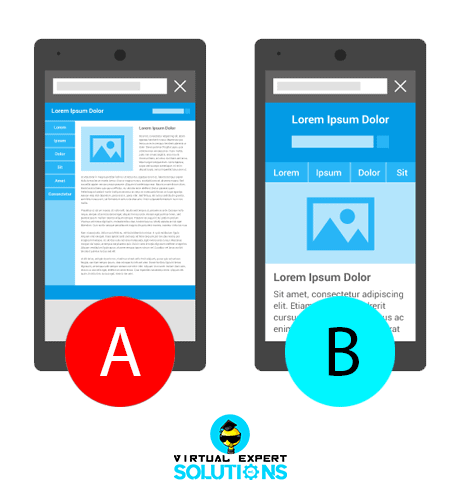Are you ready to maximize your website traffic with SEO Techniques?
Simple SEO Techniques all come down to website traffic. The more website traffic you have, the higher you will be on search engines.
SEO is currently the most effective method to achieve this. That is why it is crucial to have an in-depth understanding of it.
Why does Simple SEOImportanceuch Importance?
The answer to this question is quite simple. Almost 80% of the web traffic drives from search queries, according to HubSpot(add link)
Due to the Google algorithm’s constant updates, you must continually research and experiment with SEO. It’s essential to stay up-to-date with current trends.
In today’s times, there is not a single person who doesn’t use the internet—every single person, whether a kid or an adult, researches about a product or service before they buy it.
And when you rank on the top page of Google, your business will be more visible to people, which ultimately gives you traffic that converts. Eventually, that will also increase your overall revenue. Apply Simple SEO Techniques to rank higher in Google.
See why SEO plays a vital role in the success of your business?
You never bothered to go to the second page of the search engines. As you can see, it’s vital to be ranked on the first page of search engines.
You will be amazed to know that almost 60% of web traffic comes from the FIRST THREE organic search results. Applying SEO techniques is essential for your business website.
What’s the point in creating a well-organized, free day user website when you don’t have people to sell products/services to?
That is why we are presenting you with the 10 most effective methods you can use right away to optimize your website SEO. More people will gradually lead to more customers.
What are the techniques of SEO?
Without it, any further due here they are:
- Run an SEO audit on the website
- Find out what your users need.
- Produce SEO optimized landing pages.
- Have a mobile-friendly website as well.
- Lure traffic with infographics.
- Optimize the quality of your content for RankBrain
- At least write a minimum of 2000 words
- Post unique content on social media platforms
- Do your best to have advanced internal deep links for SEO.
- Pass link juice to lower-ranking pages.
You will learn various concepts today, including SEO techniques and tools, off-page SEO techniques, the meaning of SEO, on-page SEO techniques, types of SEO, different aspects of SEO, and SEO strategy. However, we will mainly discuss simple SEO techniques that are more critical. Be seated for the details! Because these Simple SEO Techniques need your attention 🙂
Simple SEO Techniques
We have to share the latest SEO techniques. We are going to show you Simple SEO Techniques that are needed for your website :
1. Run an SEO audit on the website:
Auditing, in simple words, means the examination of an activity, process, product, or concept, and so on. The primary reason is to determine where your website stands. What measures can you take to optimize your website for better performance? Discovering the problems associated with less traffic and sales. How to make bright decisions for the future?
SEO audit refers to the inspection of a website’s overall performance. SEO universe considers auditing to be a growth hack for websites. Why? Because you get to highlight the goals you find and the ways to achieve them. It is an exclusive technique to raise your revenue by upgrading the content you already have.
You are right to wonder why this is an exclusive technique. However, you may be surprised to learn that many websites are missing basic on-page SEO. This factor is often overlooked when creating a website, but it’s never too late to address it with an SEO Audit.

There are six simple ways to carry out an SEO Audit you need to add to your to-do list. You can cross them one by one, so here is the list:
– SEO Audit Step 01:
Examine to ensure that all the pages of your website have SEO meta titles and descriptions.
– SEO Audit Step 02:
Properly optimize your pages with SEO Keywords. You need to be extra careful and attentive for this step because we don’t want you ending up with Keyword Stuffing. If you are a beginner and finding it challenging to understand all the key terms, you can also check out our article, “SEO for Beginners.”
“Keyword Stuffing” means overloading your website with a list of keywords with the ultimate goal of manipulating ranks in Google.
– SEO Audit Step 03:
Create a URL optimized for search engines. By optimized, we mean to make it simple, short, and easy. For your better understanding, here is an example:
You already know what the blog post is about within a few seconds. You need to make a simple URL for search engines to understand the title of your post.
“Don’t make the process harder than it is?” said Jack Welch.

– SEO Audit Step 04:
Formatting the page and blog post properly is a key factor in a friendly article. What is the proper format? Your page or blog post should have:
- Headings (h1) and subheadings (h2)
- Short paragraphs, 2 to 3 sentences recommended
- Make the best use of Bold and Italic
- Add conclusion
Make it as simple as possible for the people, as they usually avoid reading confusing and cluttered blog posts. Approximately 43% of people typically skip to the end of the page to read the conclusion instead of reading the entire article. The simpler the better.
– SEO Audit Step 05:
Add keywords to the ALT tags of all your images.
– SEO Audit Step 06:
Use both internal and external links in your article. For more details on this step, refer to our post.
We also offer a quick and straightforward free tool to help you check the overall performance of your website, although it has limited features. Besides this, you can also explore Ubersuggest and Semrush. They provide free services to some extent, and if you like them, you can also buy their advanced services.
2. Find out what your users need.
Before starting any research, you need to investigate what your target customers actually want. It will help you gather related content to attract them to your website.
Another way to attract more customers is to create content based on the feedback of your regular customers. After all, the general public and customers decide whose article, blog, product, or idea/concept is worth sharing or funding.
The main question that arises here is: how to find relevant content for users’ interests?
There are many procedures to look at:
- Make good use of Social Media Platforms like Quora
- Analyze your most popular pages in Google Analytics
- Search the posts with the most shares
- Consider the comments on your blog posts
i. Make good use of Social Media Platforms like Quora
Let’s start with the first procedure. Discover where your target customers typically congregate and what topics they frequently discuss. We highly recommend Quora. Not only do you find ideas there, but you can also learn from experts on the go. It is a user-friendly and resourceful social media platform for articles, blogs, books, and concept ideas.
It is a good platform to learn new things, especially from experts from all around the world. With advanced SEO, it is not possible to know everything, so by using Quora frequently, you can cover most things about SEO. Also, it’s easy to use. You can’t imagine how much quality content Quora helps to create. All you have to do is:
- Sign up for an account
- Type in your primary target keyword
- Review the questions people are asking
- Extract ideas from experts for your content

“Tip: You can use Quora answers to form an outline for the blog post.”
ii. Analyze your most popular pages in Google Analytics
How can you use Google Analytics to find what your users need? Simple, log in to Google Analytics and, on the left-side menu, click on Behaviour > Site > All pages.
Find out which pages and posts are most popular. Analyze every column of it. The total number of pages viewed is essential, as is the average time spent, the bounce rate, and the exit percentage.

You need to point out problems within your pages by analyzing these columns. For instance, if only 40 seconds or less than that is spent on a particular page/post, then it indicates that the user didn’t find it interesting.
The bounce rate indicates the percentage of visitors to your site who leave immediately without exploring further. Although it’s not an indicator of success or failure, you do wish for people who land on your website to stay for a while.
The exit percentage is kind of similar to the bounce rate. If z% of visitors just left after landing on your page, and the rate is 99%. Then surely users aren’t finding what they are looking for.
“These are splendid ways to know so much about your own website. What needs to be done to improve your current website?”
iii. Search the post with the most shares:
Did you know that there are many great tools available on the internet to tell you how many shares your post got? BuzzSumo is one of those tools. This is yet another way to discover what people truly want.
Using BuzzSumo is quite simple; all you need to do is add your website URL and hit go. It will display a list of the most popular content, along with the number of shares it has received.

You should know that people only share your content if they genuinely believe it contains valuable information that others will find helpful and useful.
This tool highlights articles that are popular among the general public. The more they share, the more your post suggests that your content has proven to be very useful.
iv. Consider the comments on your blog posts
Your web traffic will skyrocket if you start to reply to your real users’ comments. By doing this, not only are you being attentive towards them, but you also find more content for your website from their comments.
Mark our words, every being loves to be appreciated, so do thank them for taking the time to respond to your blog and post. Receiving a positive response from you will also enhance your website’s overall image.

3. Produce SEO optimized landing pages:
Well-designed landing pages often hold importance as they should be by many businesses. We encourage you to put a great deal of effort into designing these landing pages, as they open up various pathways for new search traffic. “The more the merrier”
According to Marketing Sherpa powered by MECLABS, 44% of clicks take you to homepages instead of landing pages. A strong home page is essential, but establishing a strong relationship begins on landing pages.
To drive traffic to your website, create well-designed landing pages that effectively convey your message. If you can afford professional graphic designers, go for them. We suggest a clean and modern layout for landing pages.
The primary reason we recommend this approach is that it enables you to generate traffic through press releases, email marketing, and SEO optimization. You can take Copyblogger as your inspiration.
Here are the key elements for great landing pages:
- Try to cancel the navigation factor. Make your content resourceful, unique, and engaging enough for users to stay on your webpage.
- Interactive method: Ask users to sign up for a free trial, or consider any other method you can think of.
Remember, Copyblogger also offers a free guide on landing pages, along with helpful content on how to create an effective one. We do suggest you have a look at it.
The reason we are emphasizing this is that these pages are capable of generating substantial income. Businesses that have more than 10 landing pages have 55% more conversions than those that don’t, according to research.
For better and more significant results, we recommend a simple design and an interactive method for a landing page. We want to share simple steps with you on how to determine whether your landing pages are SEO-optimized.
Research & Use Long-Tail Keywords Throughout Your Landing Page
When writing an optimized article, it’s a complex and fast rule: “avoid keyword-stuffing at all costs”. The best way to do this is by adding keywords naturally in the content. You can also consider using similar keywords to your primary keyword. This will save you from getting penalized.
By naturally, we mean you can use your long-tail keyword in the heading, at least once in a subheading, and you can also add it in the body content as well, but only a few times.
The content of your landing page should be both helpful and persuasive, leaving users with no choice but to proceed. Here is a picture of the ideal body structure for the landing page, just for you. You can thank us by checking out our free SEO tools and by also promoting them to your friends and family.

“There are three responses to a piece of design: yes, no, and WOW! Wow is the one to aim for,“ _ Milton Glaser.
Aim for the wow while creating your landing pages. Even if your content is valuable, if it has a sinister appearance, your overall performance will ultimately fail. Design professional-looking landing pages and go for the WOW factor. After all, it is a vital part of making your pages unique.
Your landing page should feature strong yet unique content, complemented by persuasive videos, to ensure traffic that converts. Don’t forget to include testimonials from your existing customers to attract new ones.
Last but not leas,t build links for your landing pages from your existing content. Links will always be a significant ranking factor for Google. So, without high-quality links, you are far from being ranked at the top. As we mentioned above, 75 % of the traffic doesn’t even bother to look at the second page of Google. Hence, it is crucial to rank as high as you can.
4. Have a mobile-friendly website:
You should be aware that Google introduced an update to its search algorithm in May 2016. This update is designed to boost websites’ higher rankings, which are also optimized for mobile devices. That is why it is more important than ever to make your website mobile-friendly, as 60% of searches are conducted on mobile devices daily.
You do not want to risk your SEO by not having a mobile-friendly website. It’s compulsory to make your website look stunning on mobile as well in this era.
So, how can you determine if your website is mobile-friendly? Here is the best way we can explain it to you.

As you can se,e the content of the website in ‘example A’ doesn’t change at all tofitx on a smaller scree,n thus ruining the overall look of your website and its quality as well. In contrast, example B shows the duplicate content re-aligning itself while maintaining the look and quality of a website. Easy-to-read and scrollable content forms the core of the mobile-friendly concept.
If you are a WordPress user, then you don’t have to worry about your website. Because WordPress itself is responsive, it means that desktop webpages can be viewed in a size according to the device on which users are viewing them. It is a new, advanced approach to web design.
Always better to double-check everything right! The simplest way to determine if your website is mobile-friendly is to test it on your mobile device and see for yourself. Alternatively, you can also use Google’s free mobile testing tool.
You can also make a few changes to your Existing Website to make it mobile-friendly.
5. Lure traffic with infographics:
Let’s start with the term “nfographics”; these are usually a visual representation of data in a clean and clear form. Why are these so popular?
Since 65% of the population is a visual learner, this approach extends far beyond a text article. We want to share a perfect example of infographics here. NeoMam Studios has designed the importance of infographics and why they are popular and valuable.?

DESIGN INFOGRAPHICS FOR YOUR WEBSITE
If you end up with quality infographics, your traffic will double. As you have learned that people understand and prefer content that is more visually appealing than text, it is best to include infographics on your list. Now it also does not mean that you focus more on graphics and not on the “info”.
We know good design is essential, but so is the quality of information as well.
Traffic grows by 12% on the website with infographics. Why is importance given to infographics?
The human brain processes visual data 60,000 times more than text, and 90% of the information transmitted to the brain is visual. That is why you need to start considering designing infographics for your website. Not only will they bring traffic, but you can also develop quality-based backlinks when users share your infographics.
However, it will only happen if the infographic is well-designed and has quality content that users find worth sharing.
We are enlisting a few steps on how to create an infographic:
- Search for a trendy topic or an idea you think people are searching for
- Create an infographic with the help of many free websites available, such as Canva, Visual.ly, and Venngage, or you can hire a designer.
- Now write an in-depth article about the infographic you just created (the main reason is that Google considers infographics as images, but having a blog post alongside it will help Google index it, thus improving the number of your traffic.)
- Submit your infographic to a different website, such as this one.
6. Optimize the quality of your content for RankBrain:
RankBrain is the third most important ranking factor of the Google algorithm. If you want to maintain your position in top search rankings, you must always stay up-to-date with changes, as search engines continue to evolve.
RankBrain is an artificial intelligence system that analyzes data to determine the most relevant search results and identify which websites should appear in the top search results.
It tells Google spiders how to index your content based on the intent that you have provided through keywords. Avoid keyword stuffing in your content at all costs. It’s really a bad SEO practice for your website.
Pro Tip: You can avoid keyword stuffing:
- By using synonyms of your keyword in your content
- Have a natural tone in your content
- Use keywords or synonyms where necessary
The more natural your content sounds, the more your ranking will improve.
7. At least write an article of a minimum of about 2000 words:
Several studies and experiments indicate that the top five search results have an average length of 1,900 words. Here is proof of the graph from Backlinko.

We would also like to add that content length isn’t everything. An article or blog post with quality-enriched content, even if it’s not lengthy, will still outrank lengthy, low-quality articles.
Try to cover one topic in-depth that users find valuable. If the user sees it as applicable, so will Google.
8. Post unique content on social media platforms:
Utilize social media to enhance your website’s credibility and increase traffic, as your blog is new. However, not all social media platforms are considered equal when it comes to building authority and traffic.
When we discuss social platforms, we are not limited to Facebook, Twitter, and Pinterest. We are also addressing content-based platforms, such as Quora, Blogger, and SlideShare, among others.
These platforms not only help you improve your search rankings but also build links within a short period of time.

9. Do your best to have SEO advanced internal deep links:
Deep links indicate the depth of your site to Google, which encourages it to index them more thoroughly. Typically, it is the practice of using anchor text to link to other pages within your article.
Most struggle to rank on their internal pages, and often their focus is all on getting search visitors. Internal links help Google find all the relevant pages of your website, which is why establishing internal links is essential.

Improving the SEO of interlinking pages will ultimately enhance their search rankings, even for the most competitive keywords.
10. Give link juice to lower rank pages:
If you currently rank in 2 or 3 positions in Google search results, then giving quality link juice to lower pages will help you move up your rank. Essentially, link juice refers to the value of outbound links, in simpler terms.
We will guide you through simple steps on how to pass link juice to lower-ranking pages, thus improving your own website’s rank along the way.
- Update your content,
- share it across as many social media platforms as you can,
- If the content is relevant to your new post, link it to them as well.
This process takes time and doesn’t happen overnight. Actually, SEO doesn’t happen overnight; you have to put in effort.
Conclusion:
As you have read, this entire article is about gaining web traffic through simple SEO techniques. The more traffic you have, the more likely it is to convert.
You may know many marketing techniques, but Blogging is one of the most powerful marketing techniques now. This is because 82% of the population buys a product or service after reading about it. Not only this, but Blogging is considered the most trusted source for authentic information. That is why you see that many, if not almost every, brand has a blog section on their websites.
Even if a user is only researching a particular product or service, your blog post will indirectly direct them towards YOUR PRODUCTS AND SERVICES.
To maximize your blog’s potential, keep a few key points in mind. Although these exclusive yet simple techniques are challenging to implement and time-consuming, they are also effective and promising ways to double your search traffic.
The success of your WEBSITE SEO solely depends on the valuable and relevant content you provide to your target audience. It would be fun if it were done in a storytelling way.
We wish you the best of luck and hope you find this article really helpful.
Let us know in the comments if you have tried any of the Seo Techniques mentioned above, and what difference you saw after implementing them.
Last but not least, if you find this article handy, you can check out our other SEO related topics, which will teach you a lot about SEO. Now it’s your duty to apply all these Simple SEO Techniques to get ranked 😉
